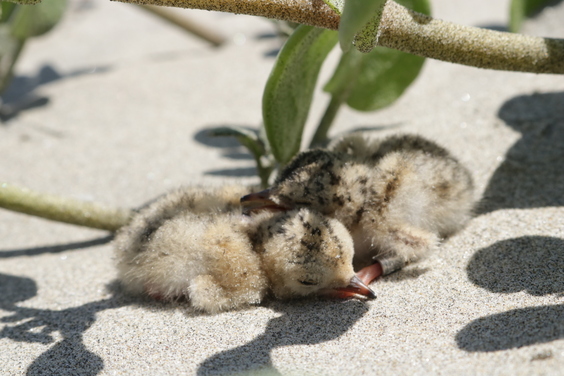By Liliana Ortiz Serrato, Pro Esteros, A.C.
The California Least Tern (Sternula antillarum browni) is a migratory seabird in the Laridae family and is the smallest of the terns. Every year during the spring and summer months, this subspecies arrives in southern California, the Baja California peninsula, and along the Pacific Coast of Mexico to reproduce. They nest near wetlands, in habitats like sandy beaches, dunes, and salt flats. South of Ensenada Baja California, in Estero Punta Banda, is home to one of the most important and largest established colonies in Baja California with approximately 70 breeding pairs. When the breeding season ends, they undertake their migration south with their chicks, where they will spend the winter. While their winter distribution is not known in detail, groups have been observed in Colima, Mexico and within Guatemala, indicating that their range extends to Central America.
Our work and experience with Least Tern

At Pro Esteros, we work for the conservation of the wetlands of Northwest Mexico. The California Least Tern is considered a species of Special Protection in Mexico and because of this, we have monitored Least Tern nesting in Estero Punta Banda since 2014. We have studied their behavior, analyzed monitoring data to determine reproductive success, compared changes in habitat quality, and documented the threats they face each year. This has allowed us to develop targeted strategies for habitat conservation and nest site protection.
Since 2018 we have delimited the nesting area with symbolic fencing to reduce human disturbance, protecting around 70 nests. Currently our efforts have increased, and since 2019, additional collaborators have joined in conservation actions including Fauna del Noroeste, Ryan Ecological Consulting, Coastal Solutions Fellow Jonathan Vargas, the Autonomous University of Baja California, as well as municipal and state authorities.
Nesting in Estero Punta Banda
Estero Punta Banda is in good conservation condition; however, natural predators and high tides have put a lot of pressure on the colony. Throughout the years we have seen a decrease in reproductive success compared to what was reported by Palacios (1992), who counted more than 160 chicks, with a hatching success of 85%. During our observations in 2019, only 7 chicks hatched, with a hatching success of 7%. However, due to strong predation, no chicks survived.

For the 2020 season our goal was to increase the reproductive success of Least Tern, which we achieved by implementing several actions. To meet our goal, we symbolically fenced the nesting area, which reduced human disturbance by 90%. We also removed invasive vegetation to provide more open space for nesting. At the same time, we installed a Fladry system (colored flagging attached to fencing) which reduced the intrusion of predators such as coyotes and foxes during the first weeks. We also implemented a system of sound repellers around the colony, which were active day and night almost the entire breeding season. After the installation of the repellers, the intrusion of predators into the colony was reduced. However, the canids still looked for a way to enter the colony through the beach. Even so, it gave the birds the opportunity to move forward with nesting and achieve greater hatching success.

Despite all the actions carried out, strong predation was observed. This was mainly by coyotes, which preyed on 50% of the nests recorded during the season. However, success was increased with a 31.61% hatch rate (equivalent to 55 chicks). Of those, 18 chicks survived to fledge, and were banded to allow follow up monitoring and wait for their return in the coming years.
With the results obtained during our monitoring work, we have noted a decreasing population trend that if it continues, could result in a more critical status designation. Continued national and international alliances are crucial to conserve this species in all its range, and thus be able to determine the current population status of this subspecies to jointly establish strategies for its conservation.

